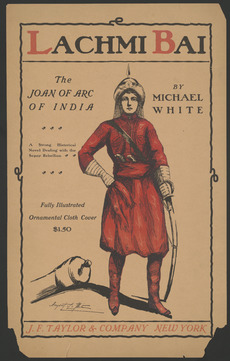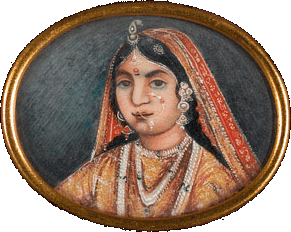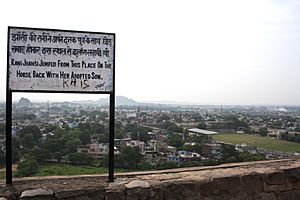Rani of Jhansi facts for kids
Quick facts for kids Rani Lakshmibai |
|
|---|---|
| Maharani of Jhansi | |

Lakshmibai dressed as a sowar
|
|
| Maharani consort of Jhansi | |
| Tenure | 1843 – 21 November 1853 |
| Regent of Jhansi (Pretendence) |
|
| Regency | 21 November 1853 – 1858 |
| Monarch | Damodar Rao (disputed) |
| Successor | Position abolished |
| Born | Manikarnika Tambe 19 November 1828 Benares, Ceded and Conquered Provinces, Company India (present-day Varanasi, Uttar Pradesh) |
| Died | 18 June 1858 (aged 29) Gwalior, Gwalior State, Company India (present-day Gwalior, Madhya Pradesh) |
| Burial | Phool Bagh, Gwalior, Madhya Pradesh |
| Spouse |
Gangadhar Rao Newalkar
(m. 1842; died 1853) |
| Issue | Damodar Rao Anand Rao (adopted) |
| Dynasty | Newalkar (by marriage) |
| Father | Moropant Tambe |
| Mother | Bhagirathi Sapre |
Rani Lakshmibai, also known as the Rani of Jhansi, was an important Indian queen. She was born on November 19, 1828, and died on June 18, 1858. She was the queen of the princely state of Jhansi from 1843 to 1853. She became queen by marrying Maharaja Gangadhar Rao.
Rani Lakshmibai was a key leader in the Indian Rebellion of 1857. She became a powerful symbol of resistance against the British rule in India for many Indian people.
Contents
Early Life and Education
Rani Lakshmibai was born Manikarnika Tambe in Varanasi (then called Benares). Her family was Marathi. Her nickname was Manu. Her father was Moropant Tambe, and her mother was Bhagirathi Sapre.
Sadly, her mother died when Manu was only four years old. Her father worked for Peshwa Baji Rao II. The Peshwa admired her and called her "Chhabili," which means "beautiful" and "lively."
Manu was educated at home. She learned to read and write, which was not common for girls at that time. She was also taught skills like shooting, horse riding, and fencing. She even practiced mallakhamba, a type of gymnastics. She learned these skills with her childhood friends, Nana Sahib and Tantia Tope. Rani Lakshmibai was known for being brave and independent. She often went against the usual expectations for women in her society.
Rani Lakshmibai loved riding horses. She often rode between her palace and the temple. Her favorite horses were Sarangi, Pavan, and Baadal. It is said she rode Baadal when she escaped from the fort in 1858. Her palace, the Rani Mahal, is now a museum. It holds many old items from the 9th to 12th centuries.
Becoming Queen of Jhansi
Manikarnika married Gangadhar Rao Newalkar, the Maharaja of Jhansi, in May 1842. After her marriage, she was renamed Lakshmibai. This new name honored the Hindu goddess Lakshmi.
In September 1851, she gave birth to a son named Damodar Rao. Sadly, he died when he was only four months old. Before the Maharaja died, he adopted a child named Anand Rao. This child was renamed Damodar Rao. The adoption happened with a British officer present. The Maharaja asked the officer to treat the child well and to let Lakshmibai rule Jhansi for her lifetime.
However, the Maharaja died in November 1853. The British East India Company, led by Governor-General Lord Dalhousie, used a rule called the Doctrine of Lapse. This rule meant that if a ruler died without a natural heir, their state would become part of British territory. Because Damodar Rao was adopted, the British did not accept him as the rightful ruler. They took over Jhansi.
When Rani Lakshmibai heard this, she famously declared, "Main apni Jhansi nahi doongi" (I shall not surrender my Jhansi). In March 1854, she was given a yearly payment of Rs. 60,000. She was also ordered to leave her palace and the fort.
Rani Lakshmibai was a very active and smart ruler. She would exercise, including weightlifting and wrestling, before breakfast. She was known for being simple in her dress and very businesslike in how she managed things.
The Indian Rebellion of 1857
The Start of the Rebellion

The Indian Rebellion of 1857 began on May 10, 1857, in Meerut. When news of the rebellion reached Jhansi, Rani Lakshmibai asked the British officer, Captain Alexander Skene, for permission to gather armed men. She wanted to protect herself and her city. Skene agreed.
Jhansi was calm at first, but the Rani performed a special ceremony called Haldi Kumkum. She did this in front of all the women of Jhansi. This was to reassure her people and show them that they should not be afraid of the British.
At this time, Rani Lakshmibai did not want to fight against the British. But in June 1857, rebels from the 12th Bengal Native Infantry took over the Star Fort in Jhansi. This fort held the city's treasure and weapons. The rebels tricked the British officers and their families into giving up their weapons. Then, they broke their promise and killed many of them.
After four days, the rebels left Jhansi. They had taken a lot of money from the Rani. They also threatened to blow up her palace. Since she was the only leader left in the city, the Rani felt she had to take charge. She wrote to Major Erskine, a British commissioner, explaining what had happened. Erskine replied, asking her to "manage the District for the British Government" until a British officer arrived.
The Rani's forces stopped a rebel group who tried to make a rival prince, Sadashiv Rao, the ruler. Sadashiv Rao was captured and put in prison.
Then, armies from British allies, Orchha and Datia, invaded Jhansi. They wanted to divide Jhansi between themselves. The Rani asked the British for help, but no help came. The British governor-general now believed she was responsible for the massacre. So, she set up a workshop to make cannons for the fort walls. She gathered her own forces, including some former allies and rebels. In August 1857, her army defeated the invaders. Even then, she still wanted to hold Jhansi for the British.
The Siege of Jhansi
From August 1857 to January 1858, Jhansi was peaceful under the Rani's rule. The British had said they would send troops, but none arrived. This made some of her advisers believe that Jhansi should be fully independent from British rule.
When British forces finally arrived in March 1858, they found Jhansi well-defended. The fort had powerful cannons that could fire over the town. Sir Hugh Rose, who led the British forces, demanded that the city surrender. If they refused, he threatened to destroy it. The Rani then made a famous statement: "We fight for independence. In the words of Lord Krishna, we will if we are victorious, enjoy the fruits of victory, if defeated and killed on the field of battle, we shall surely earn eternal glory and salvation."
The British began bombing Jhansi on March 24. But the Rani's forces fought back strongly, and they quickly repaired any damage. The defenders asked Tatya Tope for help. An army of more than 20,000 soldiers, led by Tatya Tope, came to help Jhansi. However, they were defeated by the British on March 31.
While some British forces fought Tatya Tope, others continued to attack Jhansi. By April 2, the British decided to storm the city walls. Four groups of British soldiers attacked at different points. Those trying to climb the walls faced heavy gunfire. Two other groups entered the city and moved towards the palace. There was fierce fighting in every street and every room of the palace. The fighting continued into the next day.
The Rani decided that fighting in the city was useless. She had to leave and join either Tatya Tope or Rao Sahib.
It is said that Rani Lakshmibai, with her adopted son Damodar Rao on her back, jumped from the fort on her horse, Badal. They survived the jump, but the horse died. The Rani escaped that night with her son and a few guards. This group included brave warriors like Khuda Bakhsh Basharat Ali, Gulam Gaus Khan, and Kashi Bai. She went to Kalpi and joined other rebel forces, including Tatya Tope. They took over Kalpi and prepared to defend it. On May 22, British forces attacked Kalpi again, and the Rani's forces were defeated.
Flight to Gwalior
The leaders, including Rani Lakshmibai, Tatya Tope, and Rao Sahib, fled again. They went to Gwalior and joined Indian forces who had taken over the city. The Maharaja of Gwalior had already fled. The rebels took over Gwalior without a fight. They declared Nana Sahib as the new leader, or Peshwa, of the Maratha kingdom.
Rani Lakshmibai tried to convince the other rebel leaders to prepare to defend Gwalior. She expected the British to attack soon. However, her warnings were not fully heeded. General Rose's forces took a part of Gwalior called Morar on June 16. Then, they successfully attacked the main city.
Death and Legacy
On June 17, near the Phool Bagh in Gwalior, Rani Lakshmibai was trying to leave the area. A group of British soldiers, led by Captain Heneage, fought the large Indian force she commanded. The British soldiers charged, killing many Indian soldiers.
According to one person who saw it, Rani Lakshmibai was wearing a soldier's uniform. She attacked one of the British soldiers. She fell from her horse and was wounded, probably by his sword. As she lay bleeding, she recognized the soldier and fired her pistol at him. He then killed her with his rifle. Another story says that she told a hermit to burn her body so the British could not capture it. A few local people cremated her body after she died.
The British captured Gwalior three days later. In his report, Hugh Rose said that Rani Lakshmibai was "personable, clever and beautiful" and "the most dangerous of all Indian leaders." He reported that she was buried "with great ceremony under a tamarind tree under the Rock of Gwalior."
Her tomb is in the Phool Bagh area of Gwalior.
Cultural Impact
-
The statue of Rani Lakshmibai, Shimla
-
The cremation spot (samadhi) of Rani Lakshmibai, Gwalior
-
Birthplace of Rani Lakshmibai, Varanasi
-
Rani Lakshmi Bai Park, Jhansi
Statues of Lakshmibai are found in many places across India. They often show her with her son tied to her back. Many institutions are named after her, such as the Lakshmibai National University of Physical Education in Gwalior and the Maharani Laxmi Bai Medical College in Jhansi. The Rani Jhansi Marine National Park is also named in her honor.
During World War II, a women's unit of the Indian National Army was called the Rani of Jhansi Regiment. In 1957, two postage stamps were released to remember the 100th anniversary of the rebellion.
Songs and Poems
Many patriotic songs have been written about Rani Lakshmibai. The most famous is the Hindi poem Jhansi ki Rani by Subhadra Kumari Chauhan. This poem describes her life with strong emotion and is often taught in Indian schools.
A line from the poem says: "From the bards of Bundela we have heard this story / She fought valiantly like a warrior woman, she was the queen of Jhansi."
For Marathi people, there is a well-known song about her by B. R. Tambe. It was written near the spot where she died in Gwalior.
A line from this song says: "You, denizen of this land, pause here and shed a tear or two / For this is where the flame of the valorous lady of Jhansi was extinguished."
Books and Films
Rani Lakshmibai's story has been told in many books and films. Some famous novels include Jhansi ki Rani by Vrindalal Verma and Rebel Queen by Michelle Moran. These books help keep her story alive.
Her life has also been shown in many movies and TV shows. The Tiger and the Flame (1953) was one of the first films about her. More recently, The Warrior Queen of Jhansi (2019) and Manikarnika: The Queen of Jhansi (2019) brought her story to new audiences.
She has even appeared in video games, like The Order: 1886 and Fate/Grand Order. These show how her legend continues to inspire people around the world.
See also
 In Spanish: Lakshmibai para niños
In Spanish: Lakshmibai para niños
- Indian independence movement
- Gangadhar Rao, Maharaja of Jhansi
- Jhalkaribai, a soldier of the Rani
- Company rule in India
- Tantia Tope











